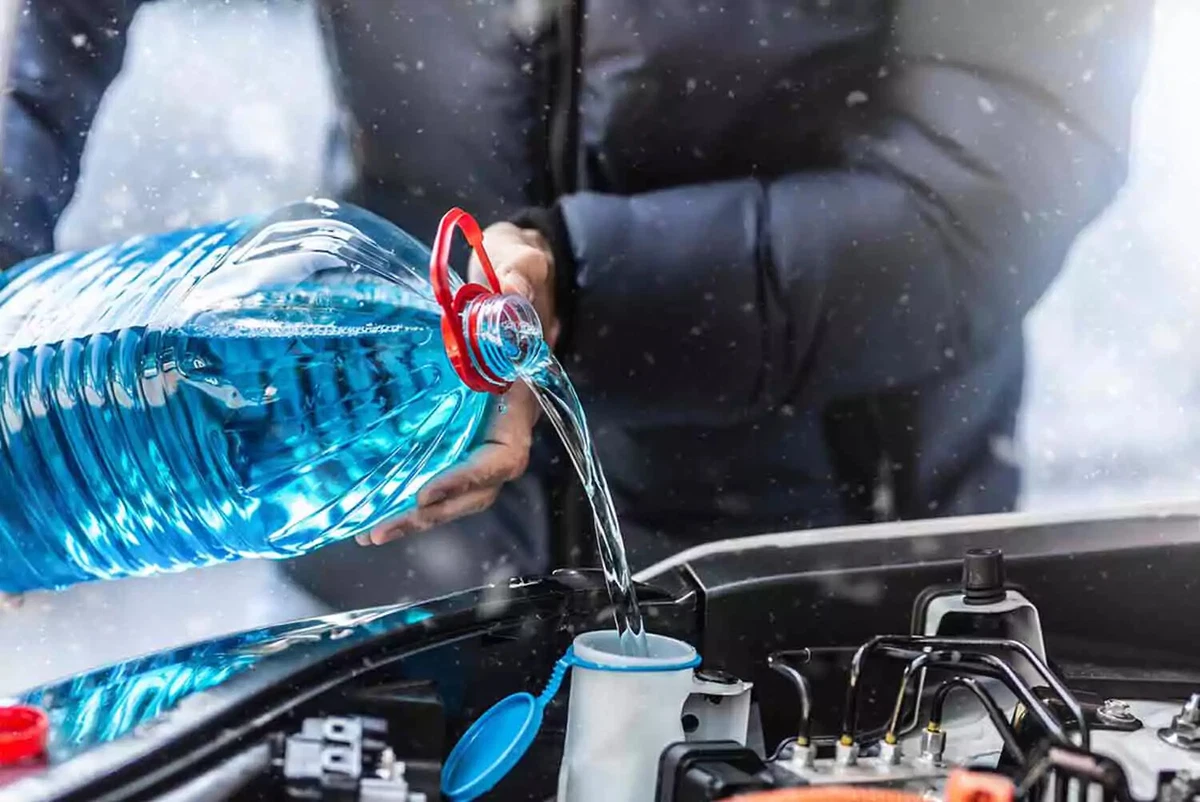Windshield washer fluid and wiper blades work together to remove grime, smashed bugs, and road salt for a clear view of the road. The touch of a button or pull on the stalk activates the windshield washer system. A pump at the bottom of the washer fluid reservoir pushes fluid through nozzles that spray the windshield, and the wipers clear the view.
How long it takes before the reservoir runs dry and what kind of windshield wiper washer fluid you need for a refill depends on where you live and drive.
Change Windshield Washer Fluid Seasonally

If you live in a cold climate, switching to low-temperature windshield washer fluid in the fall will prevent freeze-ups.
Refilling or topping off the reservoir or tank is as easy as grabbing a funnel, finding the filler cap, and pouring in washer fluid up to the fill or max line. Windshield wiper washer fluid formulations vary by season. Change your windshield washer fluid seasonally to prevent bug buildup or frozen fluid nozzles.
Switch to an all-season or winter formulation before the temperatures drop. Avoid that summer bug remover freezing up in the nozzles on the way to Thanksgiving dinner at grandma's house.
An empty reservoir is the best time to change windshield washer fluid formulations, but adding winter washer fluid to a half tank of summer blend is OK. Use a summer blend if the temperature stays above freezing year-round.
Maintaining your windshield washer system is as simple as using a fluid formulation that meets your driving requirements and manufacturer recommendations. Washer fluid ingredients also help your windshield wiper blade material stay supple for quiet operation and longer life. There are lubricants and glycol in there. Washer fluid is available pre-mixed, concentrated and in tablet form.
Do not use tap water. Minerals can leave streaks on the windshield and paint. Mineral deposits can clog the pump and nozzles. Use distilled water for mixing concentrates.
Signs Your Windshield Washer Fluid System Is Faulty

Check the nozzle jets if the windshield washer fluid spray is off-target.
With the right fluid type and formulation in the reservoir, windshield washer systems generally last the lifetime of the vehicle. Using the wrong fluid can damage the reservoir, pump, seals and lines and cause system failure. Here are a few common symptoms and possible fixes to consider if your windshield washer quits or stops spraying as it should.
Fluid leaks:
A cracked tank or hoses, loose or broken connectors, broken pump housing or bad pump seal can all cause fluid leaks. Start at the nozzles and hoses and work your way back to the reservoir and pump. The source of the leak is rarely close to where you see fluid dripping out of the bottom of the vehicle.
Laggy performance or low pressure:
Loose hose connections or a worn pump can cause low fluid pressure or a weak nozzle jet. If there's a delay between pressing the windshield washer button and nozzle spray, you might have a bad diverter or check valve. The valve keeps the lines primed so that the nozzle sprays instantly.
Off-target or uneven spray:
If the washer fluid pump, hoses, connections, and diverter valve all check out, then you might have clogged or misaligned nozzle jets. Adjust the nozzle aim if one stream sprays over the roof or onto the car next to you at the stoplight. Cleaning or replacing the nozzles can restore wonky spray pattern coverage.
Low washer fluid warning light won't go off:
If the low fluid light stays on even after you top off the tank, you might be dealing with a faulty fluid level sensor. Check for loose connections or corroded wiring first, then you can test for the correct voltage or resistance at the sensor. A faulty float can scupper switch-style sensors. Electronic sensors measure current across two pins in the reservoir.
How much does it cost for washer fluid and related repairs?
Windshield washer fluid prices vary by formulation, volume, and type, but we’re talking about pretty affordable stuff here. You might spend $10 or $20 a unit, tops. A pre-mixed gallon jug of subzero de-icer costs more than summer blends. A quart of concentrate or tube of tablets might seem more expensive upfront but cost less per gallon than pre-mixed. Washer system parts prices vary by complexity. A simple reservoir, pump, and hose setup costs less than more sophisticated heated systems.
Check out our
windshield wiper washer fluid buying guide
- opens in new window or tab.
for a roundup of the different types of washer fluids and replacement washer pumps, reservoirs, and nozzles to keep your washer system working at its best and keep your windshield clean.
Windshield Wiper Check-Up

Replacing windshield wiper blades is a simple process.
Your windshield wiper fluid reservoir inevitably runs dry at the worst time, but you can turn an inconvenience into a helpful reminder. Refilling an empty reservoir is an ideal time to check the condition of your windshield wiper blades and arms.
Check out our
DIY guide to changing windshield wipers
- opens in new window or tab.
. It has step-by-step instructions and advice about tools, supplies, and replacement parts. Consider a fresh set of dedicated winter wiper blades if you live and drive where the road salt trucks start rolling in the fall.
Draining the reservoir is only necessary if the tank gets contaminated with crude or the wrong fluid. Remove the pump and pump gasket or the entire reservoir and pump assembly if draining and cleaning are required.
Share your feedback
This article is meant to provide general guidance only. Automotive maintenance, repair, upgrade, and installation may depend on vehicle-specifics such as make and model. Always consult your owner's manual, repair guide for specific information for your particular vehicle and consider a licensed auto-care professional's help as well, particularly for advance repairs.







